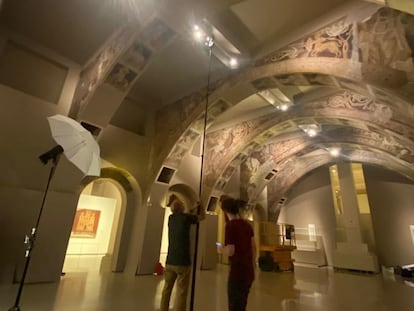
A new round of controversy has erupted in Barcelona over the famous murals from the Sijena Monastery. On Tuesday, the National Art Museum of Catalonia (MNAC) once again temporarily restricted access to its halls to prevent an inspection by a delegation from Aragón. Representatives from the Vilanueva de Sijena municipality arrived at the museum to conduct an infrared scan of the medieval frescoes but were denied access to the museum’s collections.
The museum’s management only allowed experts to work in the exhibition halls and categorically refused access to the storage areas, where the delegation believes other works from Sijena may also be kept. In addition, the museum declined to let its specialists be interviewed, despite a relevant court order. Lawyer Jorge Español, representing Aragón, insisted on his right to conduct a full inspection, but was once again refused.
In the evening, the Aragón team left the museum, but they plan to return the next day to finish their work. This marks the second time in recent months that MNAC has had to close parts of its halls due to ongoing legal disputes over the return of the frescoes. It is worth recalling that last year the Spanish Supreme Court supported Aragón’s demands and ordered the museum to return the 13th-century murals to the monastery, but the transfer process remains stalled.
Court battles and arguments from both sides
In July, specialists from the Aragon government carried out technical studies at the MNAC to assess the condition of the frescoes. The Catalan side claims that the artworks are too fragile and would not withstand transportation without serious damage. Aragonese experts, on the other hand, believe that the potential risks are minimal compared to the damage the paintings suffered when they were removed in 1936 during the civil war.
The current delegation included, in addition to a lawyer, restorers and representatives from an Italian company specializing in the diagnostics and preservation of artworks. Despite the tense atmosphere, visitors noted that the museum showed some willingness for dialogue, though it did not make concessions on the main issues.
Prospects for enforcing the court decision
A court in Huesca recently rejected another attempt by MNAC to delay the process, denying a request for an additional expert evaluation by the national cultural heritage institute. The judge indicated that she is determined to see the order to return the frescoes actually carried out. Two transfer schedules are now under consideration: the Aragon government proposes to complete the process within seven months, while the museum insists on doubling that timeframe, citing the complexity of the work.
While both sides continue to argue over the details, the fate of these unique murals remains in limbo. The conflict between Catalonia and Aragon over cultural heritage has once again become the focus of attention across Spain.






